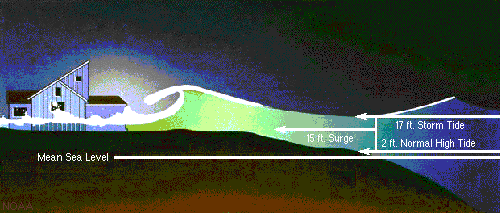 | |
| The greatest potential for loss of life related to a hurricane is from the storm surge, which historically has claimed nine of ten victims. Storm surge is simply water that is pushed toward the shore by the force of the winds swirling around the storm. This advancing surge combines with the normal tides to create the hurricane storm tide, which can increase the mean water level 15 feet or more. | In addition, wind waves are superimposed on the storm tide. This rise in water level can cause severe flooding in coastal areas, particularly when the storm tide coincides with the normal high tides. Because much of the United States' densely populated Atlantic and Gulf Coast coastlines lie less than 10 feet above mean sea level, the danger from storm tides is tremendous. Text and graphic, NOAA (National Oceanic and Atmospheric Administration). |